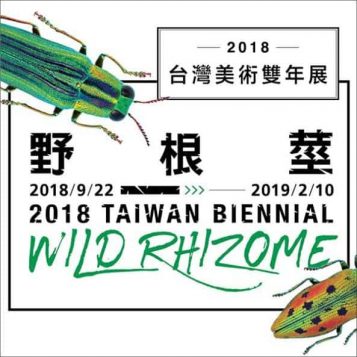Date:2018. 9. 22 – 2019. 02. 10
Venue:National Taiwan Museum of Fine Arts
Curators:Gong Jow-Jiun and Chou Yu-Ling
Artists: Uitsiann ONG, The Other Cinema Collective, WU Chi-Zeng, WU Tzu-An, WU Yao-Chung, LI Jiun-Yang, Lee Jiun-Shyan, Body Phase Studio, Rahic Talif, Blessing East Coast, LIN Yu-Ting, LIN Bo-Liang, LIN Chun-Yung, KAO Jun-Honn, CHANG Li-Ren, CHANG En-Man + YANG Wen-Shan (Kuljelje Balasasau), CHANG Wen-Hsuan, CHANG Chao-Tang, CHUANG Ling, KUO Yu-Ping, CHEN Yun, Eric CHEN + LIN Yann-Lyn. CHEN Yin-Ju, Richard Yao-chi CHEN, George CLARK, Tree Tree Tree Person – Taroko Arts Residency Project, Yannick DAUBY + TSAI Wan-Shuen, CHENG Ting, SU Yu-Xin, SU Yu-Hsien, SU Hsin-Tien, and SU Hui-Yu.
Curated by GONG Jow-Jiun (guest curator) and CHOU Yu-Ling (our in-house curator), Wild Rhizome – 2018 Taiwan Biennial will be on view from 22 September 2018 to 10 February 2019 at the National Taiwan Museum of Fine Arts. Five sub-themes — “Wild Mountains and Seas”, “Wild Images and Alternative Histories”, “Wild Body”, “Wild Constellation”, and “Wild Dwelling” — are developed from the underlying concept of “wild rhizome” and presented in multifarious forms such as visual arts, cinema, theater, settlement, seminar, and workshop. The ethos of this specific venue overgrown with organic “wild rhizome” thus manifests itself in these event-driven cross-disciplinary experiments.
Undergoing a thematic evolution from “Home” (2008) and “Yes, Taiwan” (2010-2014) to “The Possibility of an Island” (2016), the Taiwan Biennial has made every endeavor to categorize, debate, and define contemporary art in Taiwan within the rigid confines of “Taiwanese” culture and ethnic identity over the course of social, cultural, historical, ethnic, and environmental changes on this island. Wild Rhizome – 2018 Taiwan Biennial (hereafter referred to as Wild Rhizome) seeks not only to distinguish between Taiwan’s contemporary art and the identity-driven politics of exhibition, but also to liberate “Taiwan’s contemporary art,”, a term difficult to be accurately defined though, from Taiwan’s past history of colonization and immigration as well as from its nationalist ethos in search of the “national” origin, making it possible to reinvent this island by raising the question as to what Taiwan is on earth.
Configured as overgrown and intertwined plants, Wild Rhizome endeavors to address a threefold subject: the organizational structure of artistic communities, the non-linear generation of artistic events, and the constellation of alternative histories. Following the arts springing up like wild grasses from interstitial crevices, Wild Rhizome is also a response to and an attempt at the paradigm shift of art history, an exploratory journey into alternative history. As we strive to tame the kaleidoscopic frontier of alternative histories, which focuses its gaze on indigenous art practices and historical traumas in the 20th and 21st centuries outside the mainstream Han culture.
On a more specific basis, “Wild Mountains and Seas” outlines the natural history and the trauma-evoking sites for indigenous peoples, depicting contemporary art scenes based on the history of natural environment through the Jewel Beetle project, the early 20th-century survey into the Dabao tribe, the tribe of A’tolan consciousness founded in the early 21st century, the field survey of East Coast, and the marine awareness. Focusing on the avant-garde magazine Theater Quarterly (1965-1966) and the spirit intrinsic to the vibrant community formed around it, “Wild Images and Alternative Histories” is a network interlaced by the relational mappings of image, ethos, and field survey. Starting from “October”, a concatenation of spontaneous actions concerning body, montage and political metaphors taken by a group of theater professionals immediately after the lifting of martial law in 1987, “Wild Body” connects diverse practices such as folk art, experimental theater, and underground music in the 1990s. Using a material-woven philosophy as its method, “Wild Constellation” highlights the remote connections between individuals and the universe reflected in the constellation-like heterogeneous elements of the exhibits. Home is the unit of analysis of “Wild Dwelling”, which not only takes an inbound look at the stormy journey of personal spirit, but also carries out an outbound exploration of the tottering subjective identity and the hysteric imagination of the future.
Taking an innovative approach, the 2018 Taiwan Biennial revolves around the artists’ respective projects in general and large-scale site-specific works in particular. This exhibition is accomplished in collaboration with a total of 32 artists/groups, including:
Uitsiann ONG, The Other Cinema Collective, WU Chi-Zeng, WU Tzu-An, WU Yao-Chung, LI Jiun-Yang, Lee Jiun-Shyan, Body Phase Studio, Rahic Talif, Blessing East Coast, LIN Yu-Ting, LIN Bo-Liang, LIN Chun-Yung, KAO Jun-Honn, CHANG Li-Ren, CHANG En-Man + YANG Wen-Shan (Kuljelje Balasasau), CHANG Wen-Hsuan, CHANG Chao-Tang, CHUANG Ling, KUO Yu-Ping, CHEN Yun, Eric CHEN + LIN Yann-Lyn. CHEN Yin-Ju, Richard Yao-chi CHEN, George CLARK, Tree Tree Tree Person – Taroko Arts Residency Project, Yannick DAUBY + TSAI Wan-Shuen, CHENG Ting, SU Yu-Xin, SU Yu-Hsien, SU Hsin-Tien, and SU Hui-Yu.
For more information, please check National Taiwan Museum of Fine Arts Website










